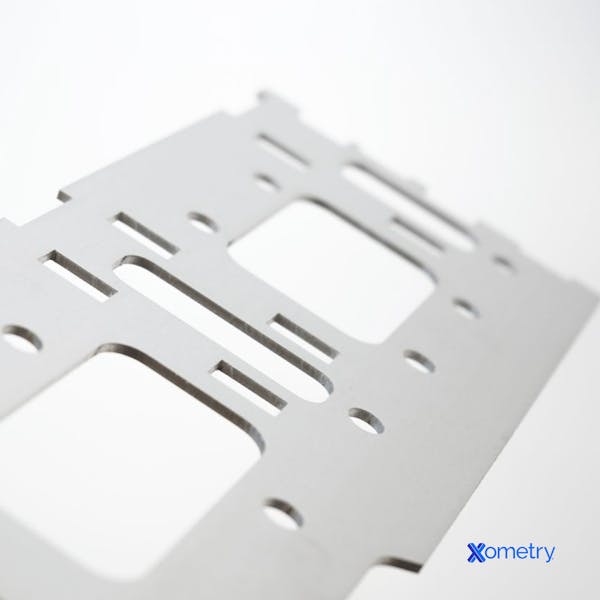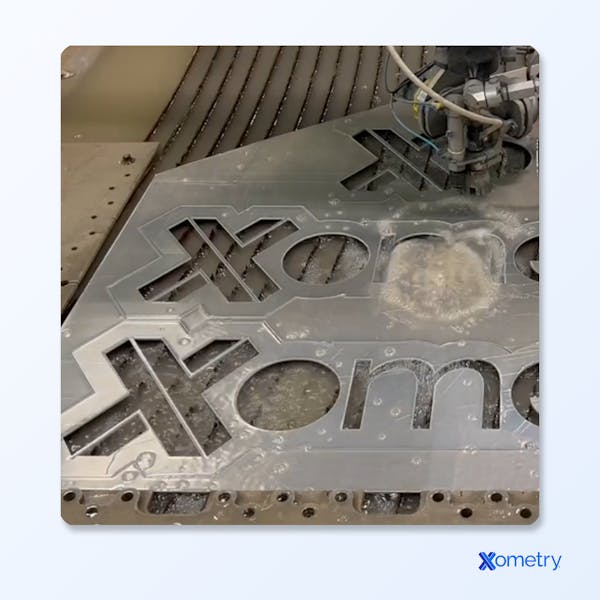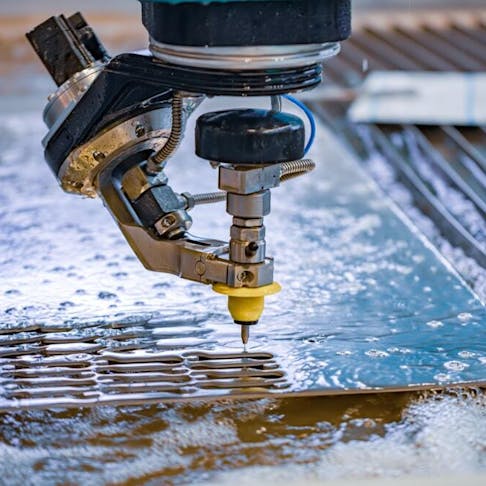Both laser cutting and waterjet cutting provide an extremely accurate and versatile way of cutting through materials, making them a couple of the most popular techniques in modern manufacturing. But they do have some significant differences, mainly in how they remove material to perform the cuts and the types of materials they are best for. In this article, we’ll go through these differences to help you better understand when to use either one.
What Is Laser Cutting and How Does It Work?
Laser cutting uses a very high-powered laser to cut or engrave materials, which it does by moving the flatbed they’re placed on. It can be performed on many materials but some of the easiest ones to laser cut are wood, cardboard, and acrylic. This technique works by burning through substances, so it releases odors as it does so. The machine generates an extremely strong, adjustable beam of light, which is focused on a tiny, seriously hot point. The path it follows has been set beforehand using CAD (computer-aided design) software in conjunction with the cutter’s own internal program. Once the cutting is done, the part can be removed. When it comes to the laser these machines use, there are two primary types: CO2 and fiber lasers. The following image shows an aluminum part that’s been laser-cut:

Laser cutters are pretty quick, with most of them generally capable of cutting at speeds of 20–70 inches per minute. That’s a lot faster than other methods, like waterjet cutting—which we’ll consider later—which can only usually handle 1–20 inches per minute. Using a laser cutter also allows you to be extremely precise, as it usually has a minimum cutting slit size of 0.15 mm. Other benefits include that it’s relatively quiet (around 75dB) and doesn’t produce much waste, whether that’s solid or liquid. A couple of downsides, though, are that lasers can only typically cut materials up to around 30-40 mm thick if you’re using an extremely powerful one—and it can produce potentially dangerous vapors, so good ventilation is a must.
Laser Cutting Advantages vs. Waterjet Cutting
Some of the advantages of laser cutting vs. waterjet cutting include:
- A laser cutter generally cuts more quickly than a waterjet cutter. A laser cutter can cut at speeds of 20-70 inches per minute, while a waterjet is generally restricted to 1-20 inches per minute.
- If precision is required in the design then laser cutting is the better choice. For a laser cutter, the minimum cutting slit size is 0.15 mm, while for a waterjet cutter is 0.5 mm.
- The laser cutting process is quieter than water jet cutting. When in use, a laser cutter makes a 75 dB sound. A waterjet cutter, on the other hand, makes a noise that can reach 90 dB.
- Laser cutting produces less solid and liquid waste than waterjet cutting because the cutting method uses only light as a cutter. Waterjet cutting produces both liquid (used water) and solid (cutting abrasive + feedstock particles) waste that has to be treated for proper recycling or disposal.
Laser Cutting Disadvantages vs. Waterjet Cutting
Some disadvantages of laser cutting vs. waterjet cutting include:
- Lasers are generally only capable of cutting materials up to about 30 mm thick, although the most powerful lasers may be able to make cuts up to 40 mm deep. However, laser cutting is not the best method for cutting thick materials. Waterjet cutting excels at slicing through parts as thick as 250-300 mm.
- Because laser cutting vaporizes a small amount of the work material, laser cutting produces potentially hazardous vapors that require a good ventilation system. In this regard, waterjet cutting is more environmentally beneficial because it generates no fumes.
What Is Waterjet Cutting and How Does It Work?
Sometimes called waterjet machining, this technique uses a high-velocity water stream to either remove material from a piece’s surface or split it entirely. Most of the time, it’s used on materials like wood, rubber, and plastic. If you want to cut through something thicker like metal or stone, then you can mix an abrasive material in with the water.
The general way it works is that water from the reservoir is pumped into the intensifier, which boosts the pressure anywhere from 5 bars to around 4,000 bars. The pressurized water sits in an accumulator, ready to be blasted. It then gets directed to the nozzle, where it’s released at speeds of around 1,000 meters per second. If an abrasive like garnet or aluminum oxide is mixed with the water, it’s housed inside a chamber within the nozzle. The water is blasted at such speeds that it actually erodes the surface it hits. If abrasives are used, the procedure is classified as abrasive waterjet cutting, but if it’s only water, then it’s called pure waterjet. This is an image of waterjet cutting in action by making a Xometry logo:

This method is amazing for thick materials and can tackle thicknesses even up to around 300 mm. Also, it doesn’t generate heat onto the workpiece, nor does it produce hazardous byproducts. Another great thing about waterjet cutting is that it can create beautifully clean and smooth cuts, which, in most cases, don’t even require any post-processing. Some potential drawbacks you might want to consider are that it can’t really maintain the same precise dimensional tolerances as laser cutting can, and when it comes to materials less than one inch thick, it can be significantly slower. Overall, waterjet cutting is considered an environmentally friendly technology, but in order to separate the used abrasive and reuse the water, you might potentially need hazardous waste disposal.
Waterjet Cutting Advantages vs. Laser Cutting
Some advantages of waterjet cutting vs. laser cutting include:
- Waterjet cutting is useful for processing thick materials. Laser cutting, on the other hand, cannot cut through as much material as waterjets.
- Waterjet cutting is a cold-cutting method and does not generate heat input to the part. Laser cutting, on the other hand, emits a high level of heat and radiation.
- Waterjet does not produce any hazardous byproducts. In contrast, depending on the material being cut with a laser, hazardous vapors may be produced and may require a ventilation system.
- Waterjet cutting produces clean and smooth cuts which typically do not need post-processing. On the other hand, laser cutting can leave some burn marks, requiring the part or affected area to be cleaned off.
Waterjet Cutting Disadvantages vs. Laser Cutting
Some disadvantages of waterjet cutting vs. laser cutting include:
- Waterjet cutting cannot maintain the same precise dimensional tolerances that laser cutters can. Laser cutting is better suited for applications that require high precision.
- For materials less than one inch thick, a laser cutter is faster than a water jet. However, for materials close to or more than one inch thick, the laser cutter's advantage begins to disappear.
- While waterjet cutting is considered an environmentally friendly technology, it requires water treatment to separate out the used abrasive before the water can be reused, and depending on the abrasive used and the material being cut, the solid waste may require hazardous waste disposal. Laser cutting, on the other hand, requires only good ventilation and an air filtering system to trap particulates from the metal vaporization process.
Laser Cutting vs. Waterjet Cutting: Cost
The initial cost of purchasing both machines has a significant difference. Depending on the brand and the features, a laser cutting machine costs between $8,000-250,000, while a waterjet cutting machine will be around $60,000-450,000. While each technology has advantages over the other, it is important to weigh several factors including: the number of parts processed, the type of material being cut, and the cutting time. For example, laser cutting is the cheapest option when cutting thin parts. However, waterjet is more cost-effective if thicker parts are being processed.
Laser Cutting vs. Waterjet Cutting: Speed
Laser cutters operate at a higher speed than waterjet cutters when cutting materials that are less than an inch thick. Laser cutters can typically cut at a pace of 70 inches per minute. The ideal speed for a waterjet cutter, however, is roughly 20 inches per minute.
Laser Cutting vs. Waterjet Cutting: Precision
Laser cutting has an advantage over waterjet cutting when it comes to precision. Although both techniques provide good accuracy, laser cutting is significantly more accurate. This can be cut with an accuracy of 0.15 mm. Waterjet cutting, on the other hand, enables a cutting precision of 0.5 mm.
Laser Cutting vs. Waterjet Cutting: Materials
The material to be cut is one of the deciding factors in selecting between the two cutting processes. Laser cutting finds relevance in a wide variety of materials which include, but are not limited to, glass, metal, plastic, and wood. Nonetheless, when it comes to reflective materials it becomes unsuitable. The reason is that laser cutting depends on light energy being delivered to the material to heat and melt or vaporize it. That process is impeded when some of the energy is reflected off the metal instead of being used to heat and cut the material. Also, it is unsuitable for thermolabile materials (materials that respond negatively to heat) because they decompose when heat acts on them.
Waterjet cutting, on the other hand, can cut a broad range of materials, except for tempered glass or diamonds. The reason is that the technology does not generate heat and instead cuts by the force of pressurized water.
Mutual Alternatives to Laser Cutting and Waterjet Cutting
Some mutual alternatives for laser cutting and waterjet cutting include:
- Plasma Cutting: Plasma cutting uses a stream of ionized gas at temperatures above 20,000 C to melt a cutting path in a material.Because the method necessitates the creation of an electric arc between the electrode and the workpiece, the materials it cuts must be electrically conductive. A plasma cutting machine can cut a variety of materials, such as: aluminum, nickel, titanium, stainless steel, plain carbon steel, etc.
- Oxy-Fuel Cutting: In oxygen-fuel cutting, metal is heated to the ignition temperature (minimum temperature required to start combustion) using a mixture of oxygen and fuel gas, such as acetylene. Afterward, a concentrated jet of pure oxygen is directed into the heated region, generating a chemical reaction between the metal and the oxygen that is exothermic. As a result, a material known as iron oxide or slag is created along the warmed region. The oxygen jet finally removes the slag, allowing it to cut through the metal. This technique cannot be used on non-ferrous metals because they form metal oxides that have higher melting temperatures than the base metal. The oxides form a protective scale over the metal instead of falling away to form a cut.
Frequently Asked Questions on Laser and Waterjet Cutting
What’s the maintenance like on these machines?
For laser cutters, you need to clean the lenses and mirrors regularly. On top of this, it’s a good idea to carry out checks periodically on the ventilation system to make sure no fumes have built up. But waterjet cutters actually need even more frequent maintenance because of the wear that the water and abrasives can cause. It’s good practice to inspect the nozzles, seals, and abrasive hoppers, and of course, treat the water to remove waste.
What safety precautions should I take for each machine?
As mentioned briefly, laser cutting requires proper ventilation. In addition, it’s a good idea to wear protective eyewear that can shield you against the intensity of the laser. With waterjet cutting, you’re dealing with high-pressure abrasives, so definitely wear protective clothing and eye protection. We also highly recommend you get some training on how to use these machines safely because they can be quite intense.
Are there any mutual alternatives to laser cutting and waterjet cutting?
There sure are! Two of the most comparable alternatives are plasma cutting and oxy-fuel cutting. The former uses a stream of ionized gas at temperatures higher than 20,000°C to melt material away, and it’s mainly used on metals. The latter heats metal to the ignition temperature, which is basically the point at which combustion starts, using a mixture of oxygen and fuel gas, like acetylene. It then blasts some concentrated pure oxygen directly into the heated area, which generates an exothermic chemical reaction between the oxygen and the metal. This creates a substance called iron oxide, or slag, along the warmed area, and the oxygen jet finally removes this, which allows it to cut through the metal. It can be used on some non-ferrous metals, too, but it won’t work as well.
How Xometry Can Help
Manufacturing and fabricating parts are more than possible at Xometry, and we have a long list of services you can get instant quotes for depending on your needs, including laser cutting and customized plastic fabrication services. Take a look at our plastic 3D printing, plastic extrusion, and plastic laser cutting pages for more information.
Disclaimer
The content appearing on this webpage is for informational purposes only. Xometry makes no representation or warranty of any kind, be it expressed or implied, as to the accuracy, completeness, or validity of the information. Any performance parameters, geometric tolerances, specific design features, quality and types of materials, or processes should not be inferred to represent what will be delivered by third-party suppliers or manufacturers through Xometry’s network. Buyers seeking quotes for parts are responsible for defining the specific requirements for those parts. Please refer to our terms and conditions for more information.


